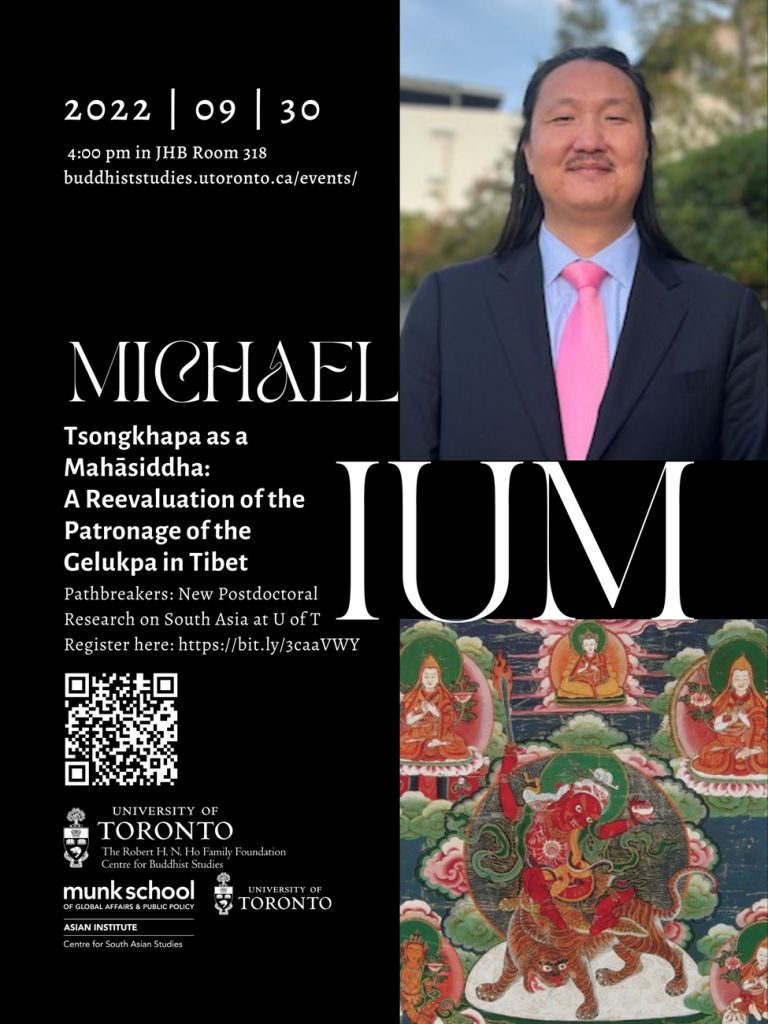After a few years of remote events due to the pandemic, the Ho Centre for Buddhist Studies was happy to return to a vibrant schedule of in-person, hybrid, and online events this Fall semester.
Michael Ium, Pathbreakers: New Postdoctoral Research on South Asia at U of T

In September, our new postdoctoral fellow Michael Ium presented a paper for the “Pathbreakers: New Postdoctoral Research on South Asia at U of T” series, co-sponsored by the Ho Centre and the Munk School of Global Affairs & Public Policy’s Asian Institute and Centre for South Asian Studies. The event was chaired by Christoph Emmrich with Rory Lindsay serving as discussant.
Michael’s paper offers a reevaluation of the early patronage of the Geluk tradition in Tibet in the fifteenth century, arguing that the influential Tibetan figure Tsongkhapa’s (1357-1419) status as a mahāsiddha or “great adept” of Buddhist Tantra was a primary (and thus far, overlooked) factor in his tradition’s gaining patronage from the political elites of the Tibetan Pakmodrupa Dynasty. Unfortunately, media from this event is not available, but a journal article on this topic has been published in the 45th volume of the Journal of the International Association of Buddhist Studies (2022). https://poj.peeters-leuven.be/content.php?url=issue&journal_code=JIABS&issue=0&vol=45
Himalayan Studies Conference

In October, the 6th Himalayan Studies Conference was organized and hosted by the University of Toronto on behalf of the Association for Nepal and Himalayan Studies (ANHS). Members of the U of T Conference Organization Team included HCBS faculty Christoph Emmrich, Frances Garrett, and Sarah Richardson. The conference was a great success, bringing together over a hundred panelists spread over eight sessions and three days.
Preceding the opening of the conference, Sarah Richardson organized an outing for attendees to see Tibetan art currently housed at the Royal Ontario Museum. This was a rare chance to see pieces that have not yet been displayed publicly, and which are in storage awaiting conservation, research, and future display. Collections Technicians Gwen Adams and Vitor Pavao hosted and answered questions about the collection’s history and current care practices.

The conference programming showcased the diversity of current research in Himalayan Studies. Some studies focused on religion, with Christoph Emmrich sharing a paper on Newar menstrual rites for the panel “Controversies on Sacred and Impure Blood.” Others focused on issues of language, with Christoph Emmrich also sharing a paper on The Newar Online Dictionary Project—a collaborative SSHRC-sponsored project based at the University of Toronto and partnering with a team from the University of Virginia—that aims to provide an online Newar dictionary that is more accessible and comprehensive.
Others focused on issues of culture, such as the panel “Religion and Culture II: Environment and Sacred Geographies” chaired by Frances Garrett. Two presenters, Jenny Bentley (University of Zurich) and Minket Lepcha (Filmmaker), shared a paper describing the workshop and mentorship program they organized for the Lepcha community in the Sikkim and Darjeeling Hills, a program supported by the “Himalayan Borderland” project under Frances Garrett. The particular aim of this project was aiding indigenous Lepcha youth to reclaim their ancestral heritage, narratives, and knowledge systems in the contemporary world.
Elsewhere, Sarah Richardson was busy chairing two panels, “Representing Himalayan Pasts and Futures through Art and Literature” and another convened to honour the legacy of John C. Huntington (1937-2021), Professor of Art History at The Ohio State University. As one of his former students, Sarah Richardson shared a paper reflecting on her first Buddhist Art course as a new MA student in Art History with Prof. Huntington, an experience that was formative and continues to shape her own research and teaching to this day.

Lastly, one of the highlights of this conference was the inaugural meeting of the Canadian Himalaya Initiative, a project aiming to facilitate greater networking and collaboration among scholars working on diverse aspects of the Himalayan region in Canada. Members gathered to introduce themselves, get to know one another, and brainstorm together, followed by a hearty dinner and social outing.
Dr. Matthew King, A Book Talk for In the Forest of the Blind: The Eurasian Journey of Faxian’s Record of Buddhist Kingdoms
The last major event in Fall Semester was a book talk by Dr. Matt King, alumni of the DSR and now Director of Asian Studies and Associate Professor of Buddhist Studies at the University of California, Riverside. This talk was well-attended both in person and online, with a lively Q and A session. A recording of this event is available on our YouTube channel here: https://youtu.be/yojSB1F34cU
The Record of Buddhist Kingdoms is a classic travelogue that records the Chinese monk Faxian’s journey in the early fifth century CE to Buddhist sites in Central and South Asia in search of sacred texts. In the nineteenth century, it traveled west to France, becoming in translation the first scholarly book about “Buddhist Asia,” a recent invention of Europe. This text fascinated European academic Orientalists and was avidly studied by Hegel, Schopenhauer, and Nietzsche. The book went on to make a return journey east: it was reintroduced to Inner Asia in an 1850s translation into Mongolian, after which it was rendered into Tibetan in 1917. Amid decades of upheaval, the text was read and reinterpreted by Siberian, Mongolian, and Tibetan scholars and Buddhist monks.
Matthew King offers a groundbreaking account of the transnational literary, social, and political history of the circulation, translation, and interpretation of Faxian’s Record. He reads its many journeys at multiple levels, contrasting the textual and interpretative traditions of the European academy and the Inner Asian monastery. King shows how the text provided Inner Asian readers with new historical resources to make sense of their histories as well as their own times, in the process developing an Asian historiography independently of Western influence. Reconstructing this circulatory history and featuring annotated translations, In the Forest of the Blind models decolonizing methods and approaches for Buddhist studies and Asian humanities.


